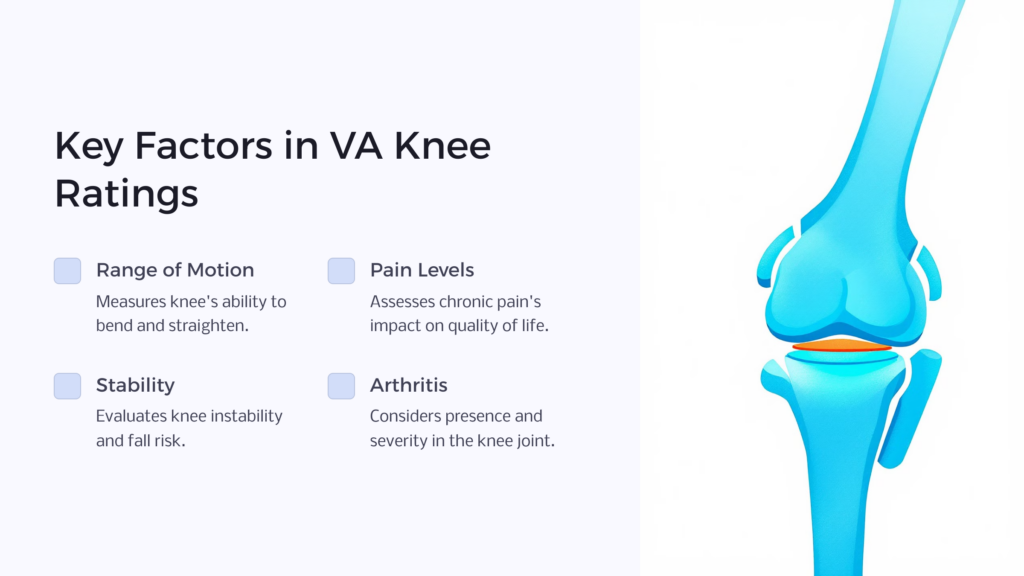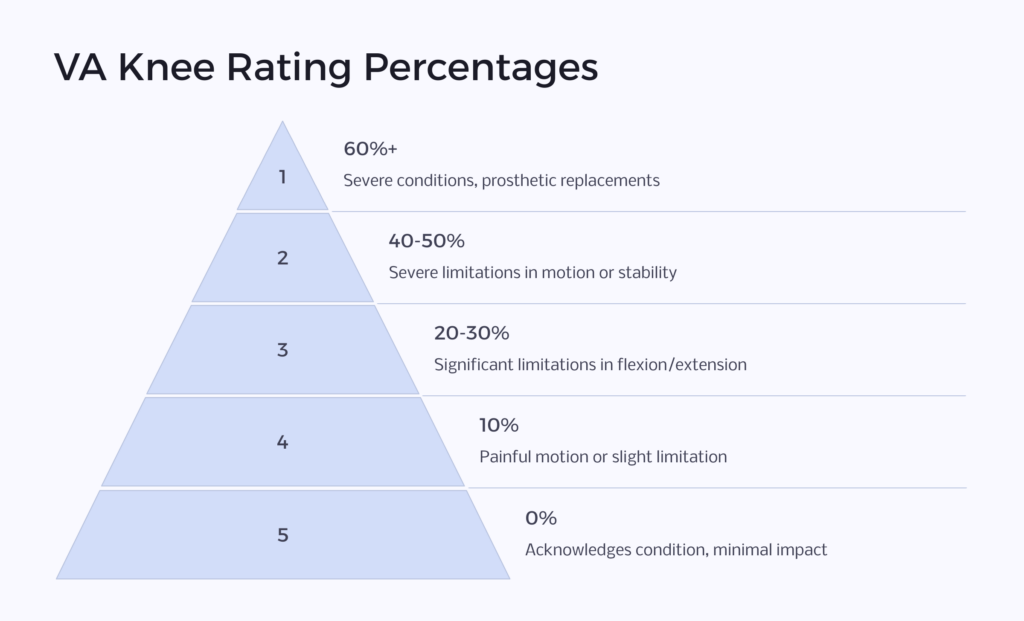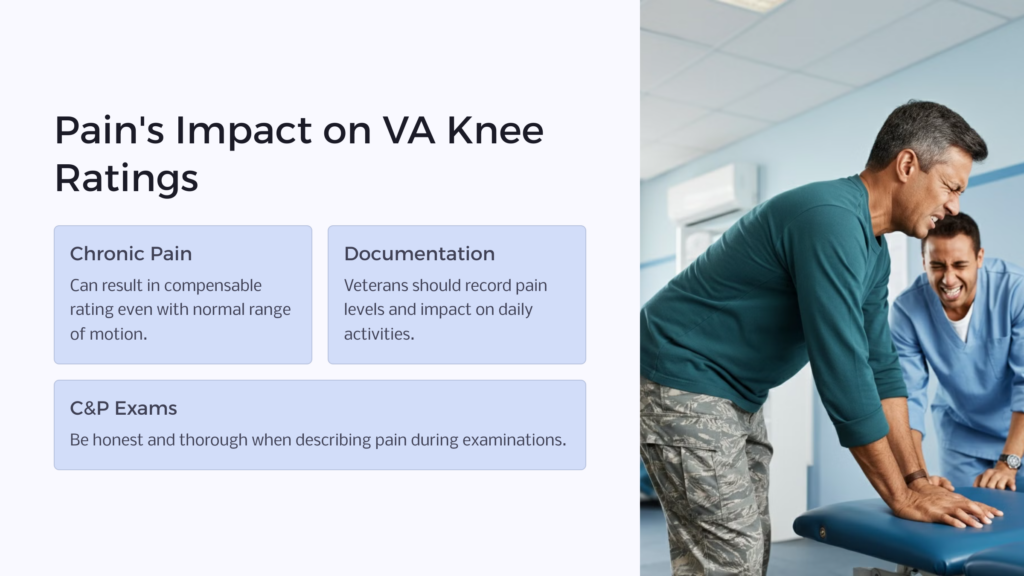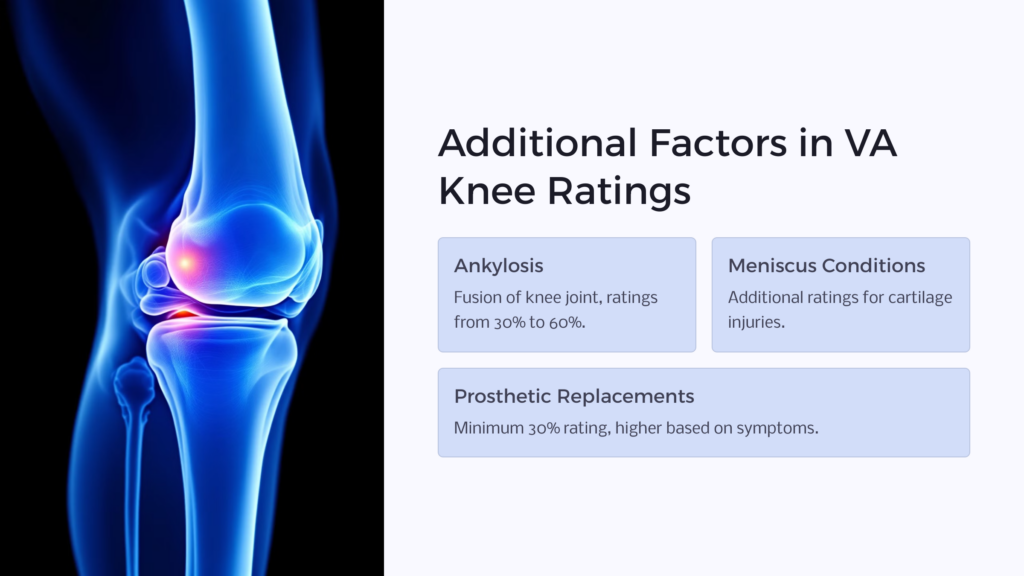The VA knee rating chart is a crucial tool used by the Department of Veterans Affairs to assess and rate knee disabilities among veterans. This chart helps determine the level of compensation a veteran may receive for service-connected knee injuries or conditions. The ratings are based on various factors, including pain, range of motion, and overall functionality of the knee joint.
Veterans who have suffered knee injuries or developed knee conditions during their military service often rely on these ratings to receive appropriate benefits. The chart provides a standardized way to evaluate the severity of knee disabilities, ensuring fair and consistent assessments across all cases.
It’s important for veterans to understand how the VA knee rating chart works, as it directly impacts their disability benefits. The ratings range from 0% to 100%, with higher percentages indicating more severe disabilities and potentially larger compensation amounts.
Key Factors in VA Knee Ratings

Several factors are considered when determining a veteran’s knee disability rating. These include:
- Range of motion: This measures how far the knee can bend and straighten.
- Pain levels: Chronic pain can significantly impact a veteran’s quality of life and ability to function.
- Stability: Knee instability can lead to falls and other complications.
- Arthritis: The presence and severity of arthritis in the knee joint.
Each of these factors is carefully evaluated by VA medical professionals to assign an appropriate rating. Veterans should be aware that their rating may change over time if their condition improves or worsens.
The VA also considers additional symptoms such as locking, swelling, and the need for assistive devices like canes or braces. These factors can contribute to a higher overall rating if they significantly impact the veteran’s daily life and ability to work.
Breaking Down the VA Knee Rating Percentages

The VA knee rating chart assigns percentages based on the severity of the knee disability. Here’s a general breakdown of what these percentages mean:
- 0%: A zero percent rating doesn’t mean there’s no disability. It acknowledges a service-connected condition but indicates that it doesn’t significantly impact function.
- 10%: This rating is often given for painful motion or slight limitation in range of motion.
- 20-30%: These ratings typically involve more significant limitations in flexion or extension of the knee.
- 40-50%: Higher ratings are assigned for severe limitations in range of motion or instability.
- 60% and above: These ratings are reserved for the most serious knee conditions, often involving prosthetic replacements or severe functional limitations.
It’s important to note that veterans can receive separate ratings for different issues with the same knee. For example, a veteran might receive one rating for limited range of motion and another for instability in the same knee.
How Range of Motion Affects VA Knee Ratings
Range of motion is a key factor in determining VA knee ratings. The VA uses specific measurements to assess how well a veteran can move their knee:
- Flexion: This measures how far the knee can bend. Normal flexion is about 140 degrees.
- Extension: This measures how straight the leg can become. Normal extension is 0 degrees (completely straight).
The VA assigns ratings based on limitations in these movements. For example:
- Flexion limited to 60 degrees might warrant a 0% rating
- Flexion limited to 45 degrees could result in a 10% rating
- Extension limited to 10 degrees might receive a 10% rating
These measurements are taken using a tool called a goniometer during a Compensation and Pension (C&P) exam. Veterans should be prepared for these measurements and understand their significance in the rating process.
The Impact of Pain on VA Knee Ratings

Pain plays a significant role in VA knee ratings. Even if a veteran has a normal range of motion, chronic pain can still result in a compensable rating. The VA recognizes that pain can limit function and impact quality of life, even if it doesn’t show up in physical measurements.
Veterans should be sure to document their pain levels and how pain affects their daily activities. This information can be crucial in obtaining an accurate rating. The VA considers factors such as:
- Frequency and intensity of pain
- Whether pain limits certain activities
- If pain causes flare-ups that further limit function
It’s important for veterans to be honest and thorough when describing their pain during C&P exams. Providing a clear picture of how knee pain impacts daily life can lead to a more accurate disability rating.
Knee Instability and VA Ratings
Knee instability is another important factor in VA knee ratings. Instability can make it difficult for veterans to perform everyday tasks and may increase the risk of falls. The VA rates knee instability separately from range of motion issues.
Ratings for instability are typically as follows:
- Slight instability: 10% rating
- Moderate instability: 20% rating
- Severe instability: 30% rating
These ratings can be combined with ratings for limited range of motion or other knee issues. For example, a veteran might receive a 10% rating for limited flexion and an additional 20% for moderate instability.
Veterans experiencing knee instability should document instances of their knee giving way or feeling unstable. This information can be valuable during the rating process.
Arthritis and VA Knee Ratings
Arthritis is a common condition among veterans with knee disabilities. The VA considers the presence and severity of arthritis when assigning knee ratings. X-rays are typically used to confirm the presence of arthritis in the knee joint.
If arthritis is present and causes painful motion, a veteran may receive a minimum 10% rating, even if their range of motion is otherwise normal. In cases where arthritis affects multiple major joints, higher ratings may be assigned.
It’s important for veterans to understand that the VA rates arthritis based on its functional impact, not just its presence. Documenting how arthritis affects daily activities and causes pain can help ensure an accurate rating.
Additional Factors Influencing VA Knee Ratings

Several other factors can influence VA knee ratings:
- Ankylosis: This is the fusion of the knee joint, severely limiting motion. It can result in ratings from 30% to 60%, depending on the position of the knee.
- Meniscus conditions: Injuries to the meniscus (cartilage in the knee) can warrant additional ratings.
- Prosthetic replacements: Knee replacements typically receive a minimum 30% rating, with higher ratings possible depending on residual symptoms.
- Muscle atrophy: Significant muscle wasting around the knee can impact ratings.
- Scars: Large or painful scars from knee surgeries may receive separate ratings.
Veterans should be aware of these additional factors and discuss them with their healthcare providers and during C&P exams if applicable.
Tips for Veterans Seeking Accurate Knee Ratings
To ensure the most accurate VA knee rating, veterans should:
- Keep detailed records of knee symptoms and how they impact daily life.
- Attend all scheduled C&P exams and be honest about symptoms and limitations.
- Provide thorough medical history, including all treatments and surgeries related to the knee condition.
- Consider getting a private medical opinion if you disagree with the VA’s rating.
- Understand the rating criteria and how they apply to your specific condition.
By being well-informed and prepared, veterans can advocate for themselves effectively throughout the rating process.
Appealing VA Knee Ratings
If a veteran disagrees with their assigned knee rating, they have the right to appeal. The appeals process allows veterans to present additional evidence or argue that the VA misapplied the rating criteria.
Steps in the appeals process may include:
- Filing a Notice of Disagreement
- Requesting a higher-level review
- Submitting new and relevant evidence
- Appealing to the Board of Veterans’ Appeals
Veterans considering an appeal should consult with a Veterans Service Organization or an accredited attorney for guidance. These professionals can help navigate the complex appeals process and increase the chances of a successful outcome.
Remember, the goal of the VA knee rating system is to provide fair compensation for service-connected disabilities. By understanding the process and actively participating in their evaluations, veterans can ensure they receive the benefits they’ve earned through their service.
We’re here to help, at Benefits.com. Check us out and take our eligibility quiz to begin your journey to benefits today.
 Benefits.com Advisors
Benefits.com Advisors
With expertise spanning local, state, and federal benefit programs, our team is dedicated to guiding individuals towards the perfect program tailored to their unique circumstances.
Rise to the top with Peak Benefits!
Join our Peak Benefits Newsletter for the latest news, resources, and offers on all things government benefits.



















